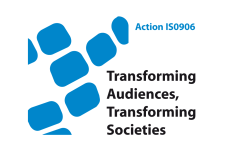- About the Action
- Events
- PhD workshop - Ljubljana 2014
- Action Open Conference - Ljubljana 2014
- New Media and Participation conference - Istanbul 2013
- Belgrade meeting 2013
- Media literacy research and policy - Brussels 2013
- ICA Pre-Conference 2013
- Tampere meeting 2013
- Budapest workshop 2012
- Milan meeting 2012
- Brussels PhD workshop 2012
- Brussels Action workshop 2012
- London meeting 2011
- Zagreb Conference 2011
- Lisbon meeting 2010
- Affiliated events
- WG 1
- WG 2
- WG 3
- WG 4
- Cross-WG
- Output
Working Group 1: New Media Genres, Media Literacy, and Trust in the Media
By Kim Schrøder
Introductory remarks about the Working Group’s field of interest, Brussels 1 March 2010.
All the four Working Groups, and thus the whole Action, are inspired by a set of common issues and problems, which receive different emphases in the four WGs. The Memorandum of Understanding, the Action’s founding document, lists four fundamental ‘problems’ in the area of audiences, to be illuminated by the work undertaken by the members: Hybridization, Participation, Technology, and Social Networks – and there is no way one can study audiences nowadays without talking about all four issues. They are interwoven dimensions of audiencehood.
In WG 1, to the extent that the WG members agree with my ideas for the WG agenda, we are going to look into people’s relation to their overall media environment of old and new media, and the various sense-making strategies they bring to bear on the media ensemble, and the individual media and their content.
1. The specific role of any medium depends on the overall matrix of media available. The media are a supermarket – and what do audiences take from the shelves and put into their shopping carts, and why? Are these practices patterned?
2. The media ensemble is characterized by hybridization of content and genres. We’re going to map this hybridization in its various manifestations in factual and fictional programming. One issue could be transmedia storytelling and multiplatform narratives, which pose challenges both for textual analysis and for audience research – not new challenges (because these things were going on before digitization and convergence), but radicalized challenges both for TV entertainment producers and for marketers, because user-generated content comes into the picture.
3. Hybridization is accompanied by a multiple blurring of boundaries: public/private, popular/elite culture, information/entertainment, production/consumption. How do audiences relate to these developments, which in the area of news and factual genres has been labelled ‘tabloidization’, and the effect on audiences as ‘dumbing down’. What does this mean for people’s trust in the media, and for the media’s capacity to build democratic prerequisites? What is citizenship anyway (an issue that overlaps with those of WG2). How can audience researchers help understand the move of ‘politics’ to other spheres than that which traditionally carries this label? What does it mean to say that politics should be seen in broader terms as ‘civic agency’ in contexts of everyday life?
4. Some quarters of audience research have countered the concern over tabloidization by claiming that audiences are media-savvy, i.e. they are critical, resistant, oppositional, etc. They have knowledge repertoires and aesthetic repertoires which enable them to handle sensibly whatever the media expose them to. Such issues, which bring us into the territory of media literacy and digital literacy, will also be in focus in WG1 (here overlapping perhaps with WG3). This moves the WG into exploring the relation between traditional receptive/decoding skills and productive/encoding skills. If audiences have become ‘prosumers’ of user-generated content, what does this mean exactly, and what is its creative potential?
As these issues will be running through the discussions in WG1, they may also lend themselves to be the focal points of specific WG seminars over the first couple of years.
Kim Christian Schrøder
Professor, Department of Communication
Roskilde University, Building 43.3
Universitetsvej 1, DK-4000 Roskilde, Denmark
Direct line: (+45) 46 74 38 08, telefax: (+45) 46 74 30 75
Email: kimsc @ ruc.dk , www.ruc.dk/komm/Ansatte/vip/kimsc/

